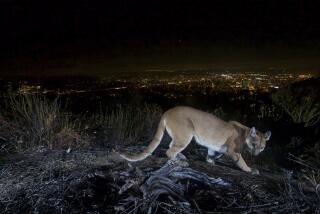Hildegarde Howard; Avian Paleontologist, Curator
Hildegarde Howard, a pioneering avian paleontologist and chief science curator emeritus of the Los Angeles County Museum of Natural History, has died. She was 96.
Howard, internationally known for her work on bird fossils from the La Brea tar pits, died Saturday in Laguna Hills, said her goddaughter Cecelia Osborn.
Known professionally as Dr. Howard, the paleontologist majored in science at the Southern Branch of the University of California (now UCLA) in the 1920s, when women were not allowed on field trips. She nevertheless earned three degrees in fossil bird research and in 1923 landed a job at the Natural History Museum picking saber-toothed tiger bones out of boxes in the basement.
She met her late husband in that basement--Henry Anson Wylde, chief of exhibitions at the museum--and married him in 1930.
Howard gradually veered away from tiger bones and to the bird bones taken out of La Brea in Hancock Park. In the 1930s she extensively studied 14,000 bones of Rancho La Brea eagles.
In 1953, cited primarily for her La Brea work over the years, Howard became the first woman awarded the Brewster Medal for outstanding research in ornithology by the American Ornithologists Union. She had been elected a fellow of the prestigious group in 1946.
Closer to home, Howard was elected the first woman president of the Southern California Academy of Sciences.
In 1977, the museum honored her by naming the Hildegarde Howard Cenozoic Hall for her. Colleagues continue to praise her for her huge volume of work, including more than 100 scientific papers.
Howard was named chief curator of science in 1951, one of the first women in the nation to reach such a position. She retired in 1961, but continued to do meticulous research at the museum on a voluntary basis.
“When your lifework is a hobby, you don’t need other hobbies,” she told The Times in 1980.
A personal favorite among the bird fossils that Howard studied was a big-beaked bird found in the Santa Barbara area in 1957. Rejecting it as a pelican or albatross, she placed it in a separate group and called it osteodontornus, meaning bony-toothed bird.
“Putting together a fossil from hundreds of bones,” she told a reporter with customary grandmotherly patience in 1958, “is something like a puzzle. It’s possible to assemble just one bird skeleton, with patience, from the pile, because only the right bone will fit the other.”
Despite her work with the Rancho La Brea site and its planned scientific digs, Howard knew paleontologists often find subjects in more casual ways.
“Curiously enough, the very tools of progress usually turn up the oldest fossils,” she said in 1958. “The first fossil found here [Los Angeles] in 1901, a flightless marine bird, was uncovered when the 3rd Street tunnel was excavated. Excavation for the San Diego Freeway uncovered some more.”
Howard had no survivors, and no funeral service is planned. Memorial contributions can be made to the Hildegarde Howard Scholarship at La Verne University in La Verne.
More to Read
Sign up for Essential California
The most important California stories and recommendations in your inbox every morning.
You may occasionally receive promotional content from the Los Angeles Times.










